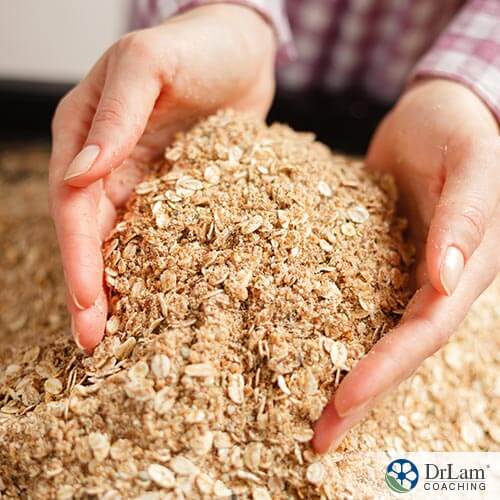 Your diet is an essential part of your overall health strategy. The foods you eat should contain all the vitamins and minerals that your body needs to function at its best, and give you the energy you need to get through your day. There are a number of health benefits you can enjoy by making small changes to your diet. A high fiber diet in particular is good for your overall health and it can help your body cope with diseases such as diabetes and Adrenal Fatigue Syndrome (AFS). So, if you want to improve your diabetes management or give your body the extra energy it needs to recover from illness, you should try adding more fiber to your diet.
Your diet is an essential part of your overall health strategy. The foods you eat should contain all the vitamins and minerals that your body needs to function at its best, and give you the energy you need to get through your day. There are a number of health benefits you can enjoy by making small changes to your diet. A high fiber diet in particular is good for your overall health and it can help your body cope with diseases such as diabetes and Adrenal Fatigue Syndrome (AFS). So, if you want to improve your diabetes management or give your body the extra energy it needs to recover from illness, you should try adding more fiber to your diet.
Fiber is found in foods such as vegetables and is a type of carbohydrate. However, unlike other carbohydrates, it can’t be broken down into sugars and passes mostly intact through your body. This doesn’t mean that fiber is useless. In fact, it has an essential role to play in maintaining your digestive health and regularity, blood sugar levels, cholesterol levels, and body weight. Unfortunately, because of the prevalence of processed foods and over-reliance on sugar, many people don’t get enough fiber in their diet, which can cause a number of health issues.
Eating a high fiber diet has a number of health benefits. It can improve your heart health, lower your cholesterol levels, and improve your gut health. It may even lower your chances of developing certain types of cancer. There are two different types of fiber, soluble and insoluble. A simple difference between these types of fiber is that soluble fiber dissolves in water and insoluble doesn’t. Your body needs both types of fiber to be healthy and to function properly. Soluble fiber can decrease blood sugar levels and cholesterol levels, while insoluble fiber improves digestion and gut health. But according to a recent study, the health benefits of eating fiber may be more important than previously thought, particularly if you have diabetes.
If you have type 2 diabetes, then you probably already know that the key to controlling this disease is to change what you eat. A recent study from China suggests that your diet may be even more important than you previously thought. In this study, two groups of people were monitored for 12 weeks. A normal diet was used by 16 people, while 27 ate a high fiber diet. Both groups also took a medication called acarbose, which slows down starch digestion so that it can reach the large intestine and be fed upon by microbes.
At the end of the study, 89% of those in the high fiber diet group showed improvements in the way their bodies managed blood sugar levels, while only 50% of the normal diet group showed the same effects. The group who ate more fiber also showed greater weight loss and had better blood lipid levels. According to these results, it seems fairly obvious that a high fiber diet improves diabetes management as well as overall health, but the real question is why.
The changes noted during the study were explored through a study of gut bacteria. Your stomach is full of billions of different bacteria. These help you digest your food and contribute to your overall health. Particularly important in this case are the strains of bacteria that produce short-chain fatty acids, because these are vital for gut health. When examining these bacteria, the study’s researchers found that 47 different strains had reduced in number from the start of the study to the end, while 15 other strains had become more abundant. The 15 strains that had multiplied are responsible for making butyric acid, which boosts insulin production and helps lower blood sugar levels. This finding suggests that these strains are vital in improving diabetes management, and that a high fiber diet is an easy and simple way to ensure that there are enough of these bacteria in your gut to make a difference to your blood sugar levels.
But even more importantly, when samples from the volunteers in the high fiber diet group were transplanted into mice, those mice also enjoyed improvements in their blood glucose levels. This further proves the effectiveness of this tactic in diabetes management and in improving overall health. And as an added bonus, increasing the amount of fiber in your diet may help with chronic conditions such as adrenal fatigue syndrome (AFS).
 AFS is a stress-related, chronic condition that causes a number of debilitating and gradually worsening symptoms. When you experience stress, your body copes by activating a system called the NeuroEndoMetabolic (NEM) stress response. This system makes changes in your body which help it cope with stress. And being able to cope with stress is key to your survival.
AFS is a stress-related, chronic condition that causes a number of debilitating and gradually worsening symptoms. When you experience stress, your body copes by activating a system called the NeuroEndoMetabolic (NEM) stress response. This system makes changes in your body which help it cope with stress. And being able to cope with stress is key to your survival.
But this system isn’t designed to cope with chronic, long-term stress. Unfortunately, the modern lifestyle is usually filled with stressors, from family relationships to finances to environmental stressors. This can cause the NEM stress response to be overused and result in fatigue. Your adrenal glands are particularly vulnerable to becoming fatigued from overuse because they’re so important to this system. They exude hormones that are vital to this stress response, particularly cortisol, and when they can no longer keep up with the demand for cortisol, it results in AFS.
The key to AFS recovery is to make changes to your diet. The modern western diet is full of high-sugar, processed foods that fill you up but don’t supply the vitamins and nutrients that your body needs to function at its best. In fact, this type of diet is so bad that it has resulted in a growing number of cases of malnutrition that persists despite overeating and even obesity. In contrast, the diet that helps with AFS recovery is based mostly on vegetables. Fresh vegetables should constitute 30% to 40% of what you eat, with the rest of your diet consisting of lean proteins, whole grains, and healthy fats.
An added benefit of this type of diet is that it will help with diabetes management. Because the best AFS recovery diet is filled with lots of healthy vegetables, it can strengthen and increase the gut bacteria which help to stabilize your blood sugar levels. This is particularly important for AFS recovery as people with this condition often suffer from blood sugar level fluctuations which cause dips in energy and result in fatigue. Helping to stabilize your blood sugar level through a high fiber diet will improve your health and energy levels and also lower the amount of stress on your body. And this is the most vital strategy to AFS recovery as it will allow your adrenal glands to rest and start to heal so they can return to full function again.
One of the most troubling and unpleasant symptoms of AFS is digestive problems. People with this condition often suffer from bouts of constipation alternating with diarrhea. In fact, AFS is strongly linked to Irritable Bowel Syndrome (IBS), a condition in which the bowels and intestines become oversensitive and irritated. This usually causes ongoing intestinal troubles and discomfort and can be very annoying and embarrassing. There is no clear consensus on what causes IBS, but chronic stress is one of the biggest triggers.
The best way to treat these kinds of problems is to improve your overall gut health with a high fiber diet. Eating healthy, fiber-rich foods can help to stabilize your bowels and intestines and alleviate symptoms of distress. If you still have trouble, a food combining diet can help as well as it allows for better digestion and nutrient absorption. Just be careful when experimenting with fiber or other diets if you have IBS. Everyone is different and making the wrong changes, or the right changes too quickly, can sometimes have distressing results and make the situation even worse. So, if you’re making these kinds of changes, make sure you go slowly and monitor your overall condition and always follow your doctor’s advice.
 It really isn’t that hard to tell if you need more fiber in your diet. The following are important signs that you should make the change to a high fiber diet:
It really isn’t that hard to tell if you need more fiber in your diet. The following are important signs that you should make the change to a high fiber diet:
Fiber helps to fill you up and creates that feeling of fullness, so if you’re still hungry, think about adding a high fiber food to your meals.
Fiber helps to stabilize your blood sugar levels, so if you’re not eating enough it can cause your energy to rise suddenly after a meal and then crash, resulting in the need for a nap.
If you often feel bloated or uncomfortable, it can be a sign that your body and digestive system needs more fiber.
Whether you’re constipated or not, your bowel movements will always reveal the truth. If you have trouble with your bowels, if it’s too small or too hard to pass, it’s a clear and unpleasant sign that you may need to try a high fiber diet.
If you decide that you want to make the change to a high fiber diet, whether it’s to help with diabetes management, aid in AFS recovery, or just to improve overall health, there are a number of changes you can make. Fiber can be found in a number of foods including the following:
Adding some of these foods to every meal will go a long way towards increasing your fiber intake and improving your health. Unfortunately, it isn’t always easy to tell how much fiber you actually need because it can vary depending on your age, your gender, and your health status. Generally speaking, women need between 22 and 28 grams of fiber a day, whereas men need between 28 and 34 grams a day. Measuring how much you actually eat is difficult, so it’s better if you just increase your fiber intake and evaluate the results. You should be able to tell from there if you’re getting enough and if your health is improving because of your efforts.
 Eating a high fiber diet is a matter of making several small changes to your diet and yet it can have a profound impact on your health. Not only does it make changes to your gut bacteria that can help with diabetes management, it can also improve your overall health. This is particularly important if you suffer from chronic conditions such as AFS, which is often strongly associated with blood sugar problems and digestive difficulties as well as a host of other debilitating symptoms. The key to recovery from this condition is to improve your overall health, and eating a high fiber diet can be an easy and safe way to do that.
Eating a high fiber diet is a matter of making several small changes to your diet and yet it can have a profound impact on your health. Not only does it make changes to your gut bacteria that can help with diabetes management, it can also improve your overall health. This is particularly important if you suffer from chronic conditions such as AFS, which is often strongly associated with blood sugar problems and digestive difficulties as well as a host of other debilitating symptoms. The key to recovery from this condition is to improve your overall health, and eating a high fiber diet can be an easy and safe way to do that.
A high fiber diet can do more for your health than just make you regular. It also changes your gut bacteria, which can help with diabetes management and speed your recovery from AFS and other conditions that cause digestive issues.